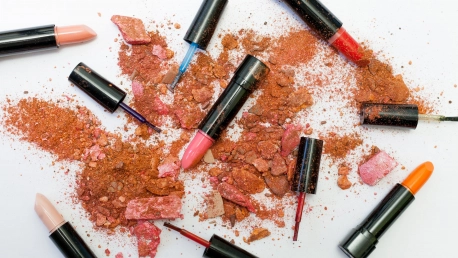In 2017, the global cosmetic products market was valued at around USD 532 billion—and is expected to reach USD 863 billion by 2024. That’s a lot of lipstick, powder, and creams. Plus, makeup and skincare have become more popular than ever, thanks to social media and influencer marketing.
Unfortunately, all this profit comes at a price. In a recent Teen Vogue article, Amy Westervelt explained the severe impact that the beauty industry has on our planet. Plastic, the material “that lasts forever” has become ubiquitous both in our households and in nature, reaching even the lowest depths of the ocean. Not only is single-use plastic debris scattered across the entire planet, but it also takes centuries or even more to break down. Furthermore, plastic waste doesn’t just exist once it reaches our ecosystems. For decades, dead and plastic-bloated birds have washed up on shores around the world. People are finding plastic debris inside fish and turtles are choking on plastic straws.
The price of beauty
Needless to say, all industries need to take action to prevent more plastic pollution—but the beauty industry has come under fire for its excessive packaging and irresponsible use of plastics. In the early 2000s, activists turned their attention to cosmetics when companies started to use plastic microbeads in scrubs and toothpaste. While these small plastic bits were banned in many countries since then and companies have pledged to phase them out, they’re still present in certain products due to loopholes in these commitments.
Microbeads are only a small part of the problem, though. If you’ve ever opened any kind of cosmetic product, you know how much plastic can go into the packaging alone, from the thin film around the box to the protective seal, and then the container itself. Half of that packaging is thrown away upon purchase and the rest follows soon after. You might be thinking that it gets recycled and then everything is fine, but in fact, according to National Geographic, a whopping 91% of plastic isn’t recycled. And even if it were, recycling isn’t a perfect solution; there is a limit to how many times plastic can be recycled and it degrades in quality each time. Furthermore, according to Amy Ziff, executive director of Made Safe, a third-party certification of beauty and household product, sometimes virgin plastic is preferred from a health standpoint since it’s difficult to ensure that recycled plastic doesn’t contain potentially harmful substances like phthalates, endocrine-disrupting plasticizing chemicals.
The only option that remains is avoiding plastic altogether. This is something that many brands are already doing, of course, by switching to glass. But according to cosmetic scientist and brand owner Sam Farmer, even glass is not as recyclable as everyone thinks, with brown-colored glass being the most viable option. Furthermore, glass is significantly heavier than plastic, which means that the carbon footprint left by transporting the product increases dramatically. It is definitely a tough balance to find, especially for companies that distribute products around the world. But that doesn’t stop some environmentally-conscious brands from trying.
Cosmetics retailer Lush has been a champion of natural, cruelty-free handmade beauty for decades. The company has made several significant steps in lowering the environmental impact of its products, from creating the first-ever solid shampoo bar to substituting almond and olive oil for mineral oil. Presently, around half of Lush products can be bought with zero packaging, and the rest are packaged using 90% recycled materials. Lush also has a program where it offers a new product in exchange for every 5 empty pots the customer brings to the store. Recently, the company has also released a range of ‘naked’ makeup items that have wax packaging and come in a cardboard box, including foundation, concealer, highlighter, and lipstick.
The rise of ethical consumption
It’s not just cosmetics companies trying to reduce waste. Some influencers, also known as ‘beauty gurus,’ have also started to fight back against the rampant consumerism and waste in the beauty industry. One such influencer, Samantha Ravndahl, recently announced that she would no longer accept PR packages from brands due to the waste generated by these gifts. Unlike regular consumer items, PR packages generally contain a larger selection or even an entire collection of makeup items. For example, when a brand releases a new lipstick, it sends the entire shade range to influencers as opposed to a selection of shades. The same goes for foundations, bronzers, and so on.
Needless to say, multiplying the number of brands that send out PR with the number of influencers on their lists gives you enough makeup to fill several landfills, probably before these beauty gurus even have a chance to use it. Granted, many influencers gift or donate any excess product, but that still leaves us with the packaging the collections come in, which generates a significant amount of varied waste material. PR packages can be quite extravagant; for example, some brands, including Marc Jacobs and Morphe, have sent out PR packages with embedded LCD screens that played promotional videos when the box was opened. More extreme examples include L’Oreal’s breakable clay ball that came with an actual hammer to promote a new hair care range and beauty Blender’s enormous makeup sponge-shaped package, both needlessly heavy and voluminous. Of course, these are just a few examples of the extravagant packages beauty gurus receive almost daily, and one has to wonder: where do all those boxes go? What about the LCD screens?
Another trend that skyrocketed in the online beauty community is the ‘anti-haul’, which was created and popularized by Kimberly Clark (a.k.a. Chris Giarmo) on Youtube. In case you’re not familiar with the term, hauls are videos where people show off their recent purchases and typically, the more products they show (and the more they spent), the better. Anti-hauls, as their name suggests, are the opposite; basically, people make videos where they discuss new releases or popular products and argue why they will not purchase each item. This trend isn’t necessarily against shopping or buying makeup altogether—instead, it advocates for shopping smarter.
The steps companies need to take
All signs point towards the end of the buy, buy, buy era. Not only are consumers looking to buy more environmentally-friendly products, but they are also cutting down on their hauls. This begs the question: how can companies adapt to the ethical consumer’s mindset while preserving margins? It may be easier than it sounds.
Addressing product packaging should be the first step in aligning your brand with these new consumer values. Switching from plastic to glass, paper or cardboard wherever possible is an obvious step. For liquid products that need to be contained in plastic, make sure that it’s recyclable. If your resources allow it, you can even start an in-house recycling program and offer free product in exchange for used packaging. They way you ship product also has a huge impact on the amount of waste your business generates—and the devil’s in the details. It’s important to find a good balance between product protection and package weight. While nobody wants to receive a broken product, shipping a single product in multiple layers of boxes and wrapping is not a good solution. Additionally, the materials you use for protection also matter. For example, it’s best if you avoid styrofoam and bubble wrap by switching to biodegradable packing peanuts. Also, if your company sends out PR packages, keep them simple and focus on the product. Disposing of PR packaging in a responsible manner can become quite a big hassle for influencers and you don’t want your gift turning into a burden.
The messages your brand puts out on social media shouldn’t encourage buying excess product or overspending. When some people say on social media that they’re going into debt to buy a certain makeup item, it’s a joke (in most cases); but when the brand makes the same joke, it can appear in bad taste. But on the other hand, you don’t want to push your customers to spend less on your brand. A great way to tackle excess shopping and create a better image for your brand is to provide multi-use products. For example, Make Up for Ever’s Artist Color Pencil is designed to perform well both on the eyes and lips and the Nudestix Cream Lip + Cheek Pencil can be used both as blush and lipstick. Products like this are better buys for consumers that want to shop smarter and get more value for their money.
The bottom line… shouldn’t come first
The truth is that it’s in everyone’s best interest to start dramatically reducing waste as soon as possible. We’ve reached a point where creating environmentally-friendly products makes both financial and ethical sense. Consumers are demanding responsibly-made products and right now, there aren’t that many brands that are truly sustainable. It’s time to go beyond marketing and greenwashing and create products that allow your business to delight customers today while keeping tomorrow in mind.









